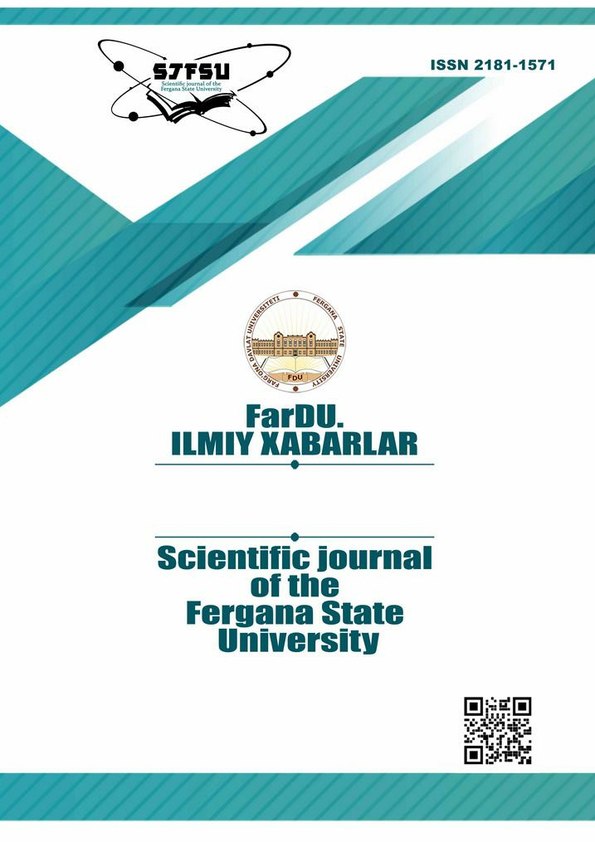AS AN OBJECT OF RESEARCH OF THE NAMES OF DISHES AND KITCHEN EQUIPMENT IN UZBEK AND ENGLISH LANGUAGE
Keywords:
Language, Uzbek, English, vocabulary, household vocabulary, thematic group, names of dishes, names of kitchen utensils.Abstract
This article describes the history of the study of the thematic group of household vocabulary dishes and kitchen utensils in English and Uzbek linguistics, and explains with examples the study of lexemes in this category in specific areas. The importance of a comprehensive study of lexical units in linguistics, their in-depth study of the language system and the internal relations between the words that make up separate lexical-semantic groups, the etymology, construction, synchronous and diachronic status of language units The study of structural-semantic, linguocultural and linguocognitive research on the example of specific languages, the achievement of a number of scientific results, the analysis of scientific works of Uzbek and English linguists in this field, the study of their different perspectives.
The research focuses on the occurrence and meaning of each lexical unit analyzed in the historical sources of the language, as well as variants of the name in the dialects of Turkic languages in the object, phraseological expressions formed with the participation of industry-specific names, onomastic cases. The etymology of nouns, their naming methods, phonetic, lexical-semantic and grammatical features, as well as morphological and syntactic words and phrases are described in detail in the work.
References
O‘zbek tilining izohli lug‘ati: 80000 ga yaqin so‘z va so‘z birikmasi. J. II.YE–M / Mas’ul muharrir A.Madvaliyev.- Toshkent: “O‘zbekiston nashriyoti” davlat unitar korxonasi, 2020. – 672 b.
Судаков Г. В. Предметно-бытовая лексика в ономасиологическом аспекте // Вопросы языкознания. 1986. – № 6. – С. 105–112.
Хайрутдинова Т.Х. Бытовая лексика татарского языка (посуда, утварь, предметы домашнего обихода). – Казань: Фикер, 2000. – 128 с.
Гауч О.Н. Семантико-этимологическая интерпретация предметно-бытовой лексики второй половины XVIII в. (на материале ТФГАТО): Автореф. дис. … канд. филол. наук. – Тюмень, 2009. – 20 с.
Ibrohimov S. Farg‘ona shevalarining kasb-hunar leksikasi. – Toshkent: Fan, 1956. – 455 b.
Dadaxonova T. O‘zbek tilida chevarchilik leksikasi. – Toshkent: Fan, 1963. – 80 b.
Tursunov T. O‘zbek tili amaliy san’at leksikasi. – Toshkent: Fan, 1978. – 138 b.;
Asomiddinova M. Kiyim-kechak nomlari. – Toshkent: Fan, 1981. – 114 b.
Usmanova Sh. Oltoy tillarida mushtarak maishiy leksika. – Toshkent: Fan, 1990.– 231.
Ismoilov I., Meliyev K. va boshqalar. O‘rta Osiyo va Qozog‘iston turkiy tillari leksikasidan tadqiqot (Mevali daraxt, poliz ekinlari nomlari va uy-ro‘zg‘or buyumlari leksikasi materiallari asosida). Toshkent: Fan, 1990. – 259 b.
Ismoilov I., Meliyev K. va boshqalar. – 259 b.
Ismoilov I., Meliyev K. va boshqalar. – 259 b.
Qarang.: Ismoilov I., Meliyev K. va boshqalar. – B. 5–71.
Gafurova L.X. Bitovaya leksika sovremennogo uzbekskogo yazika. – Tashkent: Fan, 1991. – 134 s.
Fayzullayeva M. O‘zbek taomlari bilan bog‘liq an’analar (Surxon vohasi misolida). Toshkent: YANGI NASHR, 2010. – 159.
Qarang: Fayzullayeva M. O‘zbek taomlari bilan bog‘liq an’analar (Surxon vohasi misolida). –B. 90– 10.
Mamatqulova F.A. Tilshunoslikda kulinaronimlarning lingvokulturalogik o‘rganilishi // So‘z san’ati xalqaro jurnali | Международный журнал искусство слова | International journal of word art. Серия «Филология. Социальные коммуникации». 2021, № 3 – Б. 212–218.
Павловская А. Англия и англичане / А. Павловская. – М.: ЛитРес: Самиздат, 2000. – 43 с.
Иванова Е.В. Структурно-семантические и лингвокультурные характеристики англоязычной бытовой лексики (на материале лексико-семантической группы «Посуда»): Дис. ... канд. филол. наук. – Самара, 2011. – 249 с.
Иванова Е.В. Структурно-семантические и лингвокультурные характеристики англоязычной бытовой лексики (на материале лексико-семантической группы «посуда. – 249 с.
Инч А. 1000 правил сервировки и столового этикета. Безупречные рекомендации лучшего английского дворецкого. / А.Инч, А.Херст. - М.: ACT: Астрель, 2010. – 159 с.
Инч А. 1000 правил сервировки и столового этикета. – 159 с.
https://www.liveinternet.ru/users/mudraja/post153426685/
Ayto J. A Century of New Words. Oxford: Oxford University Press, 2007. – 250 p.
Мишутинская Е.А., Пономаренко Л.Н. Способы пополнения словарного состава английского языка в XX веке // Филологические науки. Вопросы теории и практики. 2019. Том 12. Выпуск 10. – С. 238–241
Downloads
Published
Issue
Section
License

This work is licensed under a Creative Commons Attribution-NonCommercial-NoDerivatives 4.0 International License.

